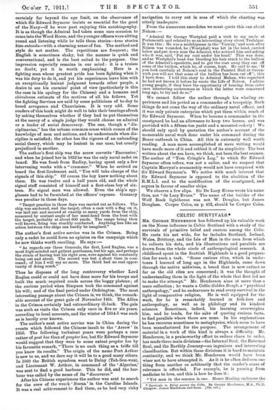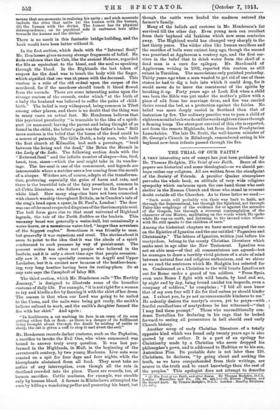CELTIC SURVIVALS.* Mn. GEORGE HENDERSON has followed up his valuable
work on the Norse influence in Celtic Scotland with a study of the survivals of primitive belief and custom among the Celts. He casts his net wide, for he includes Scotland, Ireland, Wales, Brittany, and the Isle of Man in the area from which he collects his data, and his illustrations and parallels are drawn from the whole circle of anthropological research. A childhood spent in the Scottish Highlands is a good prepara- tion for such a task. "Some curious rites, which in under- tones I learned of long ago in the Highlands, came down through the native midwives, a. breed that is now extinct so far as the old rite's are concerned ; it was the thought of understanding them in the light of the whole that first led me to make the attempt." Mr. Henderson aims at more than a mere collection ; he wants a Celtic Golden Bough, a " psychical anthropology," and he endeavours to read every survival in the light of comparative religion. He is well equipped for the work, for he is remarkably learned in folk-lore and anthropology, as well as in philology and its kindred sciences. Sometimes, indeed, his learning overweights him, and he tends, for the sake of quoting curious facts, to find parallels where there are none. In his explanations he has recourse sometimes to metaphysics, which seem to have been manufactured for the purpose. The arrangement of material in a work of this kind is always a difficulty. Mr. Henderson, in a praiseworthy effort to reduce chaos to order, has made three main divisions—the Internal Soul, the External Soul, and the Earthly journey—an ingenious and interesting classification. But within these divisions it is hard to maintain continuity, and we think Mr. Henderson would have been wiser not to have attempted it. As it is he often deduces one thing from another so arbitrarily that the reader's sense of relevance is offended. For example, he is passing from medicine to love, and this is how he does it : "Yet man in the essence is one. Hence Healing embraces tho • Sproirals in Belie) among the Celts. By George Henderson, M.A., Ph.D. Glasgow: James Idaelehose and Sons. I.10s. net.]
means that are momenta in realising his unity ; and such moments include the rites that unite (a) the human with the human, (b) the human with the divine. The former has its physical correspondence ; on its psychical side it embraces love alike towards the human and the divine."
There is no merit in this fantastic bridge-building, and the book would have been better without it.
In the first section, which deals with the "Internal Soul," Mr. Henderson gives us many strange fragments of belief. He Lade evidence that the Celt, like the ancient Hebrew, regarded the life as equivalent to the blood. and the soul as speaking through the blood. In the Highlands the last token of respect Lee- the dead was to touch the body with the finger,
which signified: that one was at. peace with the deceased. This custom is a relic of the old ordeal upon the corpse of the murdered, for if the murderer should touch it blood flowed from the wounds. There are some interesting notes upon the strange custom of the couvade, under which " at the birth of a baby the husband was believed to suffer the pains of child- birth." The belief is very widespread, being common in Tibet among other places, and there is no doubt that the thing was in many cases an actual fact. Mr. Henderson believes that
this psychical peculiarity " is traceable to the idea of a spirit- part (or man,soul) leaving the parent and being thought of as found in the child,; the latter's gain was the father's loss." Still more curious, is the belief that the bones of the dead could be a source of paternity. The Gille Dubh, a holy man, who built the first church- at Kilmallie, had such a parentage, " bred between the• living and the dead," like Brian the Hermit in.
the Lady, of the Lake. The following section deals with the " ExternalSoul" and the in-finite number of shapes—bee, bird, beast, tree, stone—which the soul might take in its wander- ings. The bee-souL is one of the commonest, and legends are innumerable where a watcher sees a bee coming from the mouth
of a. sleeper. Witches are, of course, adepts at the transforma- tion, preferring especially the guise of hares and cats, and
there is the beautiful tale of the fairy sweetheart, common to all Celtic literature, who follows her lover in the form of a white hind. How many stag-rites have not been connected with church worship throughout Britain, as in Camden's tale of•
the stag'a head- upon a. spear, in St. Paul's, London ! The deer
was one of the most respected disguises of the theriomorphic soul. The bull form gave rise to that most universal of Highland legends, the tale of the Tarbh Boibhre or the boobrie. This uncanny beast was generally a water-ball, but occasionally a
water-horse, ors monstrous water-bird, " larger than seventeen of the biggest teem." Sometimes it was friendly to man.
but generally it was rapacious and cruel. The storiesabout it seem to point to the idea that it was the abode of a spirit
condemned to such penance by way of punishment. The
present writer has often met people who believed in the boobrie, and it is only a short time-ago that people occasion- ally- saw it. It was specially common in Argyll and Upper Lochaber, but it is extinct now because of the heather-burn-
ing, very long heather having been its resting-place. So at any rate says the Campbell of" IslayMS.
The third section, which Mr. Henderson calls "The Earthly Journey," is designed to illustrate some of the homelier customs of daily life. For, example, "it is not right for a woman to try and kindle a fire by fanning it with the skirt of her dress The reason is that when our Lord was going to be nailed to the Cross, and the nails were being got ready, the smith's bellows refused to work, and the smith's daughter fanned the fire with her skirt." And again:
" In Loehbroom, a cat washing its face is an. omen of its soon getting either fish or flesh : as there is a danger of its fulfilment being brought about through the death by mishap of cattle or sheep, the cat is given a cuff to stop it and avert the eviL" Mr. Henderson records darker customs, such as the Taghairm, a sacrifice to invoke the Evil One, who when summoned was
bound to answer truly every question. It was last per- formed in the Highlands, in Mull, in the beginning of the
seventeenth century, by two young Macleans. Live eats were roasted cm a spit for four days and four nights, while the hierophants abstained from, all food. They must take no notice of any interruption, even though all the cats in. Scotland crowded into the place. There are records, too, of human sacrifice. Cattle madness, for example, was curable
only by human blood. A farmer in Kinlochewe attempted the cure by killing a wandering pedlar and procuring his heart; but though the cattle were healed the madness entered the farmer's family.
Many of the beliefs and customs in Mr. Henderson's list survived till the other day. Even young men can recollect from their boyhood old fashions which now seem centuries away. The Highland world has changed very sharply in the last thirty years. The wilder rites like human sacrifices and the sacrifice of bulls were extinct long ago, though the second was practised at Applecross_ a century ago,.and the first sur- vives in the belief that ta think water from. the skull of a dead man is a cure for epilepsy. Mr. Macdonald of Applecross, writing in 1902,. reported this custom as still extant in Torridon. The sacredstone only perished yesterday. Thirty years age -when a. man wanted to get rid of one of these stones. he had to dig a. hole inta which it could drop, for it would never do to incur the resentment of the spirits by breaking it up. Forty years ago at Loch Eck when a child was born the Bible was put. under the mother's pillow with a piece of silk from her marriage- dress, and fire was carried thrice round the bed, as a protection against the fairies. No belief was more deeply rooted in. Scotland than that of lustration by fire. The ordinary practice was to pass a child of eighteen months back wards and forwards eighteen times through a flaming hoops The strangest. survival of this. rite is reported, not from the remote Highlands, but from donee Presbyterian Lanarkshire. The late Dr. Scott, the well-known minister of St. George's Church in Edinburgh, remembered seeing in his boyhood new-born infants passed through the fire.































































 Previous page
Previous page